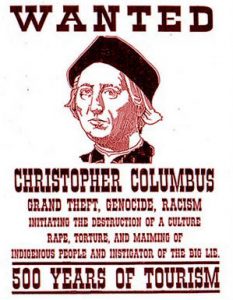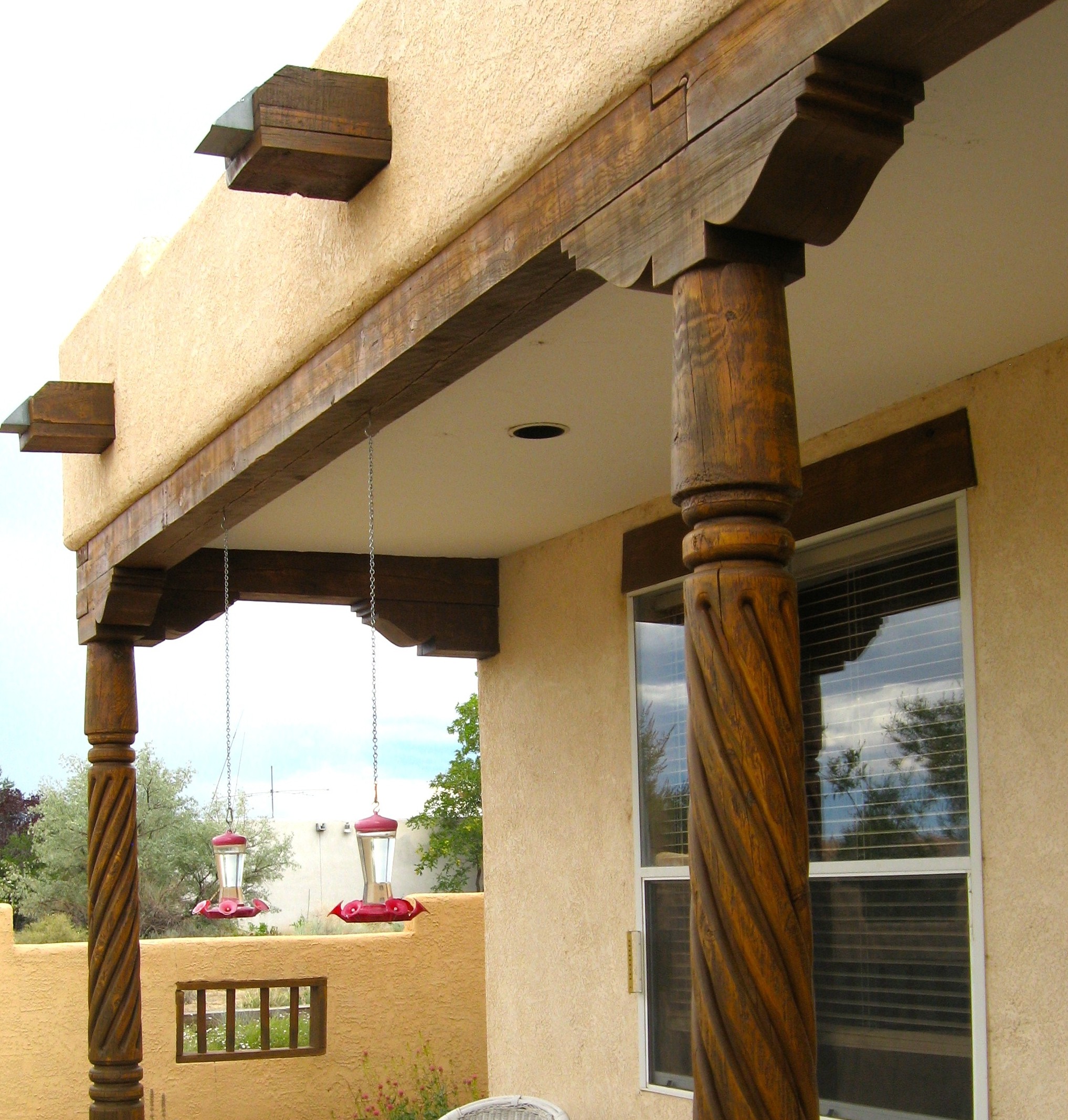This is an updated version of a post from 2017.
Columbus Day used to be a really boring holiday (unless you’re Italian). Now it’s nearly as controversial as, say, a football game, as a growing number of cities dump Christopher Columbus in favor of Indigenous People. 2021 update: Looks like it’s a national holiday now.
 I’m all for giving indigenous folks their own holiday, perhaps in March or April, and don’t begrudge government workers yet another day off. But it’s hard to escape the impression that re-naming the holiday is more about dissing Chris than celebrating the indigenous.
I’m all for giving indigenous folks their own holiday, perhaps in March or April, and don’t begrudge government workers yet another day off. But it’s hard to escape the impression that re-naming the holiday is more about dissing Chris than celebrating the indigenous.
Whether or not Columbus was a bad hombre personally, his principal accomplishment was to open the Western Hemisphere to Spanish colonization. So are the anti-Columbus folks saying that the continent would be a better place if the Spanish had never interfered with idyllic folk like the Mayans? If so, doesn’t that disparage Hispanic Americans?
For a closer look at Columbus’ legacy, consider my adopted home state of New Mexico: Hispanics make up 45% of the population and Native Americans another 10%. The result is a rich, blended culture that makes Columbus impossible to erase and Native Americans impossible to dismiss.
Many New Mexicans trace their families all the way back to Spain (because the priests that accompanied the Spanish invaders recorded all the baptisms and marriages). They are unlikely to agree that their ancestors should have stayed there instead of following Columbus – especially when the family tree includes the occasional Native American. Some New Mexicans have embraced the “indigenous” label themselves because their families were on the land before it was part of the United States.
Update: I’ve been studying New Mexico history and find that the state has its own ethnic melting pot. The “Spanish” who colonized the place were a racially mixed bunch when they got here. New Mexico was practicing diversity and inclusion a couple of centuries before it became fashionable.

If Columbus had never arrived, my house would be a Cape Cod.
The Spanish arrived in 1541 and their influence is everywhere: in architecture, religion, art, food, etc. Spanish is the state’s official second language and practically every place has a Spanish name (including the street where I live).
Native American influence is nearly as strong. While indigenous populations were evicted from most other states, Navajos and Apaches returned to their ancestral lands after the displacements of the Nineteenth Century and the 19 pueblos never left. So while Native Americans may be a political abstraction in New York and Washington, they’re neighbors and co-workers in New Mexico.
Over the centuries the two cultures have co-existed and blended. Santa Fe’s two biggest art events are Spanish Market and Indian Market. You can see Indian dances and flamenco in the same day in Albuquerque. Catholic churches on the pueblos have a distinctive Native American atmosphere. New Mexico’s unique cuisine combines both traditions on the same plate.
Reconciling Columbus’ legacy is an ongoing process here. Everyone acknowledges that the Conquistador ancestors of my neighbors enslaved the Indians and converted them to Catholicism at swordpoint. For the past 300 years Santa Fe’s biggest festival has celebrated the Entrada, the 1692 “bloodless reconquest” of New Mexico by the Spanish after the Pueblo Revolt in 1680 kicked them out. The bloodless part was a whitewash, it turns out, and the city is re-thinking the festival.
A monument in Santa Fe erected in 1868 commemorates the soldiers who fought against the “savage Indians.” The word “savage” has been chiseled out. Update: The Santa Fe monument was torn down by rioters in the first “celebration” of Indigenous Peoples Day last year. (No great loss: It was a pretty ugly monument.) There’s an opportunity to create an exciting new monument that symbolizes unity. A committee has been formed.
A few years ago the Taos town council removed Kit Carson’s name from a local park because of the famous explorer’s role in a brutal forced migration of Navajo people. They changed the name back again because Kit’s buried there, but discussion is likely to continue.
There’s a high school team called the Redskins. It’s on the Navajo reservation and everybody’s cool with it. An elderly state senator closes every session of the legislature by singing a Navajo song. It’s a tradition.
When the “Occupy” protests popped up a few years ago, the local version called itself “(Un)occupy Albuquerque” to protest the 400-year occupation of Native American land.
In a more sensible way to cast off colonialism, a couple of New Mexico’s pueblos voted to revive their Native American names. The Spanish had named the pueblos for the churches they forced the inhabitants to build. So San Juan Pueblo is now Ohkay Owingeh and Santo Domingo is Kewa Pueblo.
Albuquerque and Santa Fe are joining the national movement to replace Columbus Day with Indigenous Peoples Day, but Hispanic city employees still get the day off. Meanwhile, New Mexico’s celebration of its blended culture will continue to evolve with updated monuments and festivals. And folks who want to atone for Columbus’ sins against indigenous people can pay reparations at the nearest Native American casino.

Columbus and my neighbors
This is an updated version of a post from 2017.
Columbus Day used to be a really boring holiday (unless you’re Italian). Now it’s nearly as controversial as, say, a football game, as a growing number of cities dump Christopher Columbus in favor of Indigenous People. 2021 update: Looks like it’s a national holiday now.
Whether or not Columbus was a bad hombre personally, his principal accomplishment was to open the Western Hemisphere to Spanish colonization. So are the anti-Columbus folks saying that the continent would be a better place if the Spanish had never interfered with idyllic folk like the Mayans? If so, doesn’t that disparage Hispanic Americans?
For a closer look at Columbus’ legacy, consider my adopted home state of New Mexico: Hispanics make up 45% of the population and Native Americans another 10%. The result is a rich, blended culture that makes Columbus impossible to erase and Native Americans impossible to dismiss.
Many New Mexicans trace their families all the way back to Spain (because the priests that accompanied the Spanish invaders recorded all the baptisms and marriages). They are unlikely to agree that their ancestors should have stayed there instead of following Columbus – especially when the family tree includes the occasional Native American. Some New Mexicans have embraced the “indigenous” label themselves because their families were on the land before it was part of the United States.
Update: I’ve been studying New Mexico history and find that the state has its own ethnic melting pot. The “Spanish” who colonized the place were a racially mixed bunch when they got here. New Mexico was practicing diversity and inclusion a couple of centuries before it became fashionable.
If Columbus had never arrived, my house would be a Cape Cod.
The Spanish arrived in 1541 and their influence is everywhere: in architecture, religion, art, food, etc. Spanish is the state’s official second language and practically every place has a Spanish name (including the street where I live).
Native American influence is nearly as strong. While indigenous populations were evicted from most other states, Navajos and Apaches returned to their ancestral lands after the displacements of the Nineteenth Century and the 19 pueblos never left. So while Native Americans may be a political abstraction in New York and Washington, they’re neighbors and co-workers in New Mexico.
Over the centuries the two cultures have co-existed and blended. Santa Fe’s two biggest art events are Spanish Market and Indian Market. You can see Indian dances and flamenco in the same day in Albuquerque. Catholic churches on the pueblos have a distinctive Native American atmosphere. New Mexico’s unique cuisine combines both traditions on the same plate.
Reconciling Columbus’ legacy is an ongoing process here. Everyone acknowledges that the Conquistador ancestors of my neighbors enslaved the Indians and converted them to Catholicism at swordpoint. For the past 300 years Santa Fe’s biggest festival has celebrated the Entrada, the 1692 “bloodless reconquest” of New Mexico by the Spanish after the Pueblo Revolt in 1680 kicked them out. The bloodless part was a whitewash, it turns out, and the city is re-thinking the festival.
A monument in Santa Fe erected in 1868 commemorates the soldiers who fought against the “savage Indians.” The word “savage” has been chiseled out. Update: The Santa Fe monument was torn down by rioters in the first “celebration” of Indigenous Peoples Day last year. (No great loss: It was a pretty ugly monument.) There’s an opportunity to create an exciting new monument that symbolizes unity. A committee has been formed.
A few years ago the Taos town council removed Kit Carson’s name from a local park because of the famous explorer’s role in a brutal forced migration of Navajo people. They changed the name back again because Kit’s buried there, but discussion is likely to continue.
There’s a high school team called the Redskins. It’s on the Navajo reservation and everybody’s cool with it. An elderly state senator closes every session of the legislature by singing a Navajo song. It’s a tradition.
When the “Occupy” protests popped up a few years ago, the local version called itself “(Un)occupy Albuquerque” to protest the 400-year occupation of Native American land.
In a more sensible way to cast off colonialism, a couple of New Mexico’s pueblos voted to revive their Native American names. The Spanish had named the pueblos for the churches they forced the inhabitants to build. So San Juan Pueblo is now Ohkay Owingeh and Santo Domingo is Kewa Pueblo.
Albuquerque and Santa Fe are joining the national movement to replace Columbus Day with Indigenous Peoples Day, but Hispanic city employees still get the day off. Meanwhile, New Mexico’s celebration of its blended culture will continue to evolve with updated monuments and festivals. And folks who want to atone for Columbus’ sins against indigenous people can pay reparations at the nearest Native American casino.
Share this: